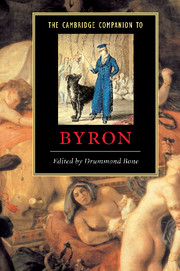Book contents
- Frontmatter
- Introduction
- Part 1 Historical Contexts
- Part 2 Textual Contexts
- 5 Heroism and history
- 6 Byron and the Eastern Mediterranean
- 7 1816-17
- 8 Byron and the theatre
- 9 Childe Harold iiv, Don Juan and Beppo
- 10 The Vision of Judgment and the visions of 'author'
- 11 Byron's prose
- Part 3 Literary Contexts
- Select bibliography
- Further reading
- Index
9 - Childe Harold iiv, Don Juan and Beppo
from Part 2 - Textual Contexts
Published online by Cambridge University Press: 28 May 2006
- Frontmatter
- Introduction
- Part 1 Historical Contexts
- Part 2 Textual Contexts
- 5 Heroism and history
- 6 Byron and the Eastern Mediterranean
- 7 1816-17
- 8 Byron and the theatre
- 9 Childe Harold iiv, Don Juan and Beppo
- 10 The Vision of Judgment and the visions of 'author'
- 11 Byron's prose
- Part 3 Literary Contexts
- Select bibliography
- Further reading
- Index
Summary
Whereas Childe Harold ii and ii sought the goal of their pilgrimage in the classical world of Greece, at the boundary of civilization and Nature, and Canto iii seeks its elusive goal in Nature beyond civilization, Canto iV concentrates on the high civilization of the Renaissance and of Rome. While obviously to some extent dictated by Byron's own whereabouts, the move also expresses a very significant shift in his world view. In Manfred (pp. 118) we have seen how the individual becomes responsible for the meaning of his or her own life. This is a secular view of meaning, seeing life as a construct of man's own mental activity. This mental activity is represented in and by civilization and culture. Life made meaningful has the form of an artwork - it is a product of civilization and culture. This is the view that dominates Canto iV. The canto opens with the famous image of the Bridge of Sighs in Venice:
I stood in Venice, on the Bridge of Sighs;
A palace and a prison on each hand:
I saw from out the wave her structures rise
As from the stroke of the enchanter’s wand:
A thousand years their cloudy wings expand
Around me, and a dying Glory smiles
O’er the far times, when many a subject land
Look’d to the winged Lion’s marble piles,
Where Venice sate in state, thron’d on her hundred isles!
(CHP, iv.1)- Type
- Chapter
- Information
- The Cambridge Companion to Byron , pp. 151 - 170Publisher: Cambridge University PressPrint publication year: 2004
- 2
- Cited by



